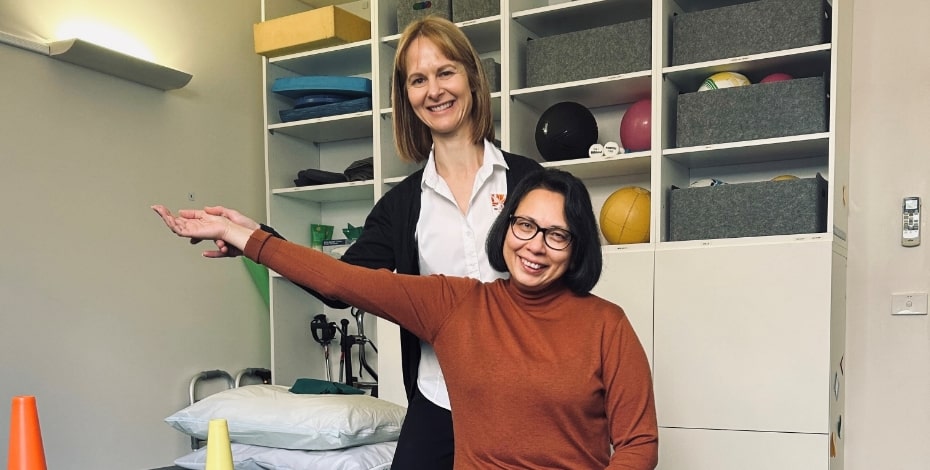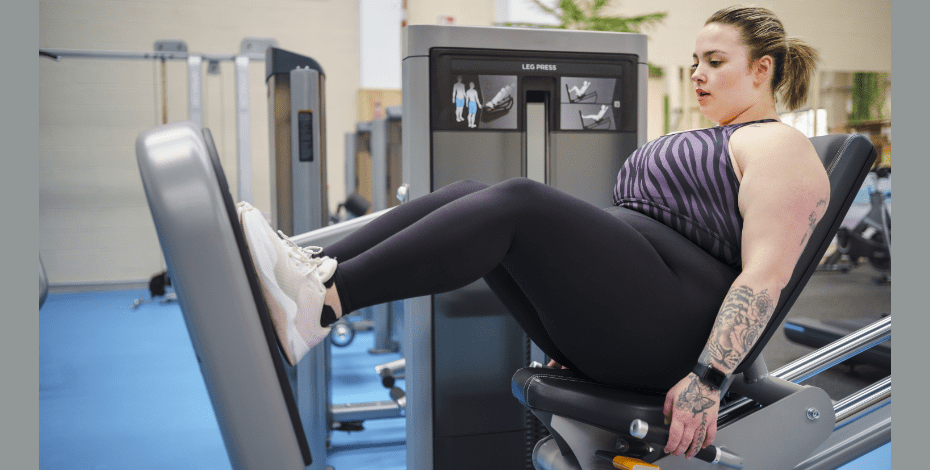
Passion for neuro physio motivates Kate

On the eve of World Polio Day on 24 October, InMotion speaks with Kate Seeliger, a private practitioner who has recently begun working with patients impacted by polio and its delayed effects. Here, Kate talks to Melissa Mitchell about what she has learnt about polio, her physiotherapy career over more than 20 years and her keen interest in neurology.
Although there is no definitive data on the prevalence of the late effects of polio (LEoP) or post-polio syndrome (PPS) in Australia, it is estimated that hundreds of thousands of individuals are either affected by or at risk
of developing the conditions.
Some people who contracted polio as a child without experiencing symptoms at that time may still be at risk of developing LEoP or PPS.
The role that physiotherapy and exercise can play in helping people with polio, LEoP and PPS is something that APA Neurological Physiotherapist Kate Seeliger APAM MACP has experienced first-hand as a private practitioner in South Australia.
After initially learning about polio sequelae as a team leader of rehabilitation with The Physio Clinic in 2021, Kate and others at the practice linked with Polio Australia to upskill in treating patients with polio conditions.
She then began to treat clients with LEoP and was asked to present on the topic at education sessions run by Polio SA.
‘Our understanding of the pathophysiology of poliomyelitis and LEoP has improved over the past two decades.
'It has become increasingly clear that the initial motor neuron decline, the faster-than-usual subsequent decline with ageing and ongoing additional stresses on muscles and joints all contribute to the three most common symptoms reported by the polio survivor—fatigue, pain and weakness.
'These symptoms can combine to be quite debilitating.
'I feel that it is absolutely essential that this population be given every opportunity to manage these symptoms and maintain their optimal function and lifestyle.
‘Historically, polio survivors may have been advised not to exercise for fear that it might be harmful and adversely affect their condition. Fortunately, we now know that this is not necessarily the case.
'While there are some specific considerations that we must take into account when treating polio survivors and prescribing exercise therapy, a sensible balance of tailored exercise and recovery time can help to maintain health and prevent the negative consequences of inactivity and deconditioning.
'Exercise is only one aspect of the multidisciplinary, patient-centred approach that is required for the optimal, holistic care of the post- polio client,’ Kate says.
Kate continues to work with clients with LEoP, admiring their courage and resilience.
While two of the three poliomyelitis strains have been eradicated around the globe, migrants from Pakistan and Afghanistan, where strain 1 is still active, and Australians born in the pre-polio-vaccine era of the 1940s and 1950s make up the majority of clients seeking help with LEoP and PPS.
Some of the clients Kate sees present multiple challenges for treatment, with symptoms that can include fatigue, muscle weakness, joint pain and increased sensitivity to cold.
‘[Treatment involves] trying to find exercises and working within the limits of their fatigue.
'It’s a bit different from standard exercise, where we might try to push someone as hard and as fast as we can.
'There are some precautions needed with the polio population. We don’t want to work very weak muscles because they’re already working hard just to do day-to-day life things.
'It becomes a matter of trying to work out how to best challenge them without causing any adverse effects.
'A lot of polio survivors have had negative experiences with exercise in the past, where their capability boundaries may not have been recognised, so they detach from wanting to do any kind of exercise therapy.
'But it’s just that it hasn’t been prescribed in the right way,’ Kate says.
Kate also works with clients who need neurological rehabilitation, a passion she’s had since working as a new graduate physiotherapist in rotation positions at the Royal Adelaide Hospital.
Kate was rotated through a range of hospital areas as a new graduate, including general medicine, orthopaedics, respiratory and outpatients (in the acute setting), but it was when she worked in the hospital’s Hampstead Rehabilitation Centre that her love of neurological rehabilitation began in earnest.

Kate Seeliger graduated from the University of South Australia in 2000.
‘I was attracted to neurological rehabilitation because I felt that I had the opportunity to make a meaningful difference to people’s lives.
'People with neurological conditions can experience difficulties with physical function including problems with muscle strength, range of movement, coordination, sensation, balance and mobility,’ Kate says.
‘Neurological rehabilitation utilises the principles of neuroscience, neuroplasticity, movement science and exercise therapy to guide treatment aimed at improving an individual’s physical function and independence.
'The impact that we can have on someone’s functional capacity and quality of life is enormous.
'People who live with neurological conditions are inspiring.
'I am often left in awe of their commitment and dedication to self- improvement, their willingness to engage in therapy and tackle new challenges and their quest to live better lives.’
Knowing she wanted to work in health but that she didn’t want to be a doctor, Kate originally studied physiotherapy at the University of South Australia, where she says she fell in with her ‘tribe’.
‘They [physiotherapy students] had the same perspective on health, exercise and wellbeing as I did. 'It was about wellness before “wellness” was a term. I loved that approach to life.
'It was nice to find a like-minded group of people who prioritised exercise and eating well and social engagement and all the things we now recognise as being quite good for us,’ Kate says.
Kate graduated from the University of South Australia in 2000 and became a member of the APA the same year.
The new graduate immediately set out to learn as much as she could about being the best practitioner possible for her clients.
It is a raison d’être that Kate has carried for more than 20 years, through a career that has taken her overseas and home again and has given her deep personal and professional satisfaction for decades.
Like many young physiotherapists fresh out of university, Kate set off to travel overseas after her stint at the Hampstead Rehabilitation Centre.
She held various locum positions across the UK and Europe, several in little-known places off the beaten tourist track including Northampton, in the East Midlands region north of London; Haywards Heath, directly south of London; and Ashton-under-Lyne, near Manchester.
‘Australian physios were quite well regarded in the UK and it was an incredible opportunity for a young physio to be able to move across hospitals and work with different teams and clinicians.
'I was happy to work outside London, which meant being placed in a range of ‘country/rural’ locations… the people were lovely and it was a lot of fun.
'Being free to travel between locum rosters was certainly a highlight.
‘On a more sombre note, working within the National Health Service gave me a greater appreciation for the health system we have in Australia.
'This has been reinforced now that we have the National Disability Insurance Scheme, which has been life- changing for many disability clients.
'For me, working in the UK also underlined the rigour and strength of the Adelaide undergraduate physiotherapy program at the time.
'Along with my experience at the Royal Adelaide Hospital, that equipped me to work successfully in England and I felt I could make a really positive contribution while I was working there.’
After her experiences working in neurological rehabilitation overseas, Kate returned home to Adelaide and took up a short-term contract at the Hampstead Rehabilitation Centre before joining a well-regarded private neurophysiotherapy practice in Adelaide.
At the same time, she worked as a clinical educator at her alma mater, the University of South Australia, supervising undergraduate students at Flinders Medical Centre.
‘Early on in my career we were starting to be referred more and more clients for dizziness and imbalance,’ Kate says.
‘This led us to pursue further training in this specialised area and I subsequently developed a keen interest in vestibular physiotherapy and treating clients with dizziness and vertigo.
'I found it immensely satisfying to be able to help clients overcome the conditions.
‘I find that working with clients with vestibular disorders can be incredibly rewarding.
'Dizziness, disequilibrium, imbalance and falls can all impose major restrictions and limitations on a person’s life and negatively affect their wellbeing and function.
'Many of the peripheral vestibular disorders can respond very well to vestibular therapy and rehabilitation, and people can regain full function or have a resolution of symptoms.
'In fact, one of the most common vestibular disorders, benign paroxysmal positional vertigo, can often be completely resolved in one or two treatment sessions, much to the delight of both the client and the clinician.
‘There is a growing body of evidence to support the role and efficacy of vestibular rehabilitation and a gradually increasing awareness among medical professionals of what physiotherapists can offer people with vestibular disorders, in acute settings such as emergency departments and in the community.’
In late 2007, Kate set her sights on becoming an APA Neurological Physiotherapist.
She had worked in the area for more than seven years and met the other requirements, including passing an exam, which she did in 2008.
‘The process of titling was created after I had already been a physiotherapist for several years.
'Given that a lot of my work was in the field of neurophysiotherapy, I felt it would be a good opportunity to be part of a process that could reassure me that I had the knowledge, skills and credentials to adequately treat clients with neurological conditions,’ Kate says.
‘I also thought it might signal to both clients and referrers that this is my area of passion and expertise.
'It was good to know that an external body was happy with my level and depth of knowledge and experience in treating clients with neurological disorders.’
Kate says physiotherapy has provided her with many professional highlights including one patient with Parkinson’s disease with whom she has worked weekly for 11 years. (‘He attributes his ongoing ability to
walk to his physiotherapy treatment. Such incredible commitment from this man and his wife to get to therapy every week.’)
Kate has enjoyed working with a diverse range of clients from many cultural and personal backgrounds.
She draws enormous professional pride from having previously helped clients take their first steps after having a stroke or accident.
She also delights in helping clients return to work, exercise, driving or caring for their family after feeling dizzy or unstable and being highly anxious about their situation.
‘Physiotherapy is an opportunity to make a significant difference to people’s lives through improving their health outcomes.
'There are so many different areas you could work in, such as acute respiratory in the hospital, community paediatrics, occupational health, research, sports or neuro,’ Kate says.
‘And there’s flexibility in how you perform your work. You can set your own hours or fit work in around your family.
'If you’re in research, there’s an opportunity to work from home.
'As well as offering flexibility, it is a profession that allows you to be creative in the way you deliver your therapy.
'There are opportunities for self-employment or being an employee.
'There’s the ability to work interstate, overseas and in a variety of settings.
‘Physiotherapy is also very conducive to part-time work, which some other professions, such as law, might not be.
'It’s particularly good for people thinking about whether they want to have a family and a career, as I have done.’
© Copyright 2024 by Australian Physiotherapy Association. All rights reserved.






